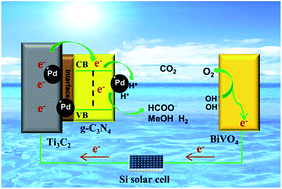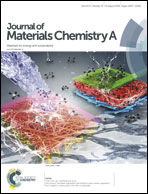Highly efficient photoelectrocatalytic reduction of CO2 on the Ti3C2/g-C3N4 heterojunction with rich Ti3+ and pyri-N species†
Abstract
Photoelectrocatalytic (PEC) reduction of CO2 into chemical fuels in water is a promising route to mitigate the energy crisis and global warming issues. Herein, Ti3C2/g-C3N4 (TCCN) heterojunctions were fabricated by in situ heat treatment and were applied to PEC CO2 reduction. These heterojunctions have narrow band gaps (2.3–2.6 eV) and rich Ti3+ species, which are beneficial to the absorption of solar light and the separation of electrons and holes. Besides this, the abundant pyri-N species in the TCCN heterojunctions can adsorb CO2 molecules, which is favourable for CO2 reduction. The deposition of nanometal particles can accelerate charge transfer. In a two-electrode system of M–TCCN‖BiVO4, the total formation rate of formate and methanol was as high as 50.2 μM cm−2 h−1 (25.1 mM h−1 g−1), which is tenfold that of pristine g-C3N4. The carbon source of the products was verified by a 13CO2 labeling experiment. These heterojunctions show outstanding PEC performance and stability and are promising candidates in the solar-to-fuel engineering field.



 Please wait while we load your content...
Please wait while we load your content...